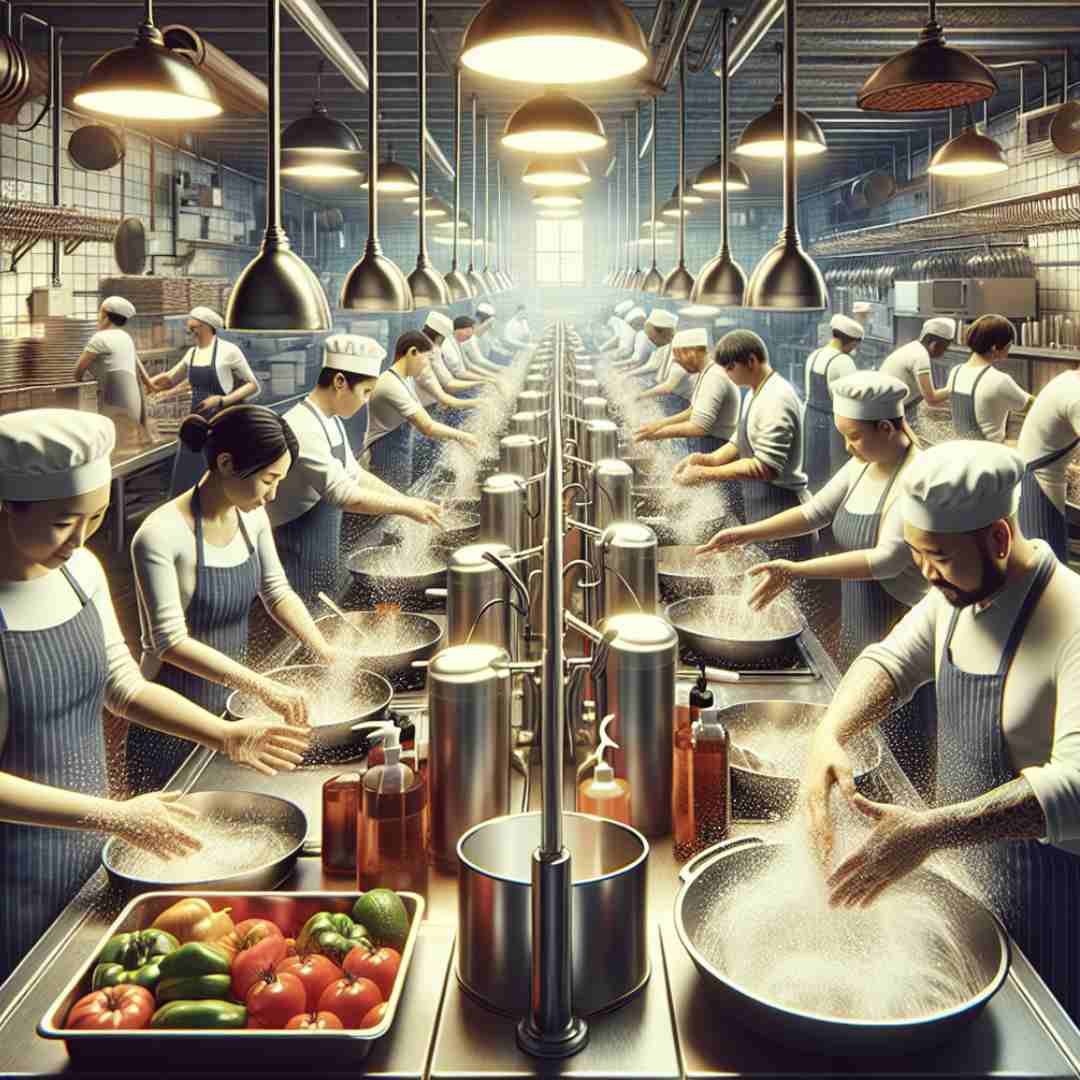Picture this—a bustling restaurant kitchen filled with sizzling pans, tantalizing aromas, and food workers diligently prepping meals. Amidst the culinary magic, ensuring cleanliness and safety is paramount, especially regarding hand hygiene. Washing hands may seem simple, but doing it correctly and in the right place can significantly impact food safety. This guide will explore where food workers should wash their hands and the importance of proper hygiene practices. It will also offer insights into maintaining a safe and healthy kitchen environment.
The Importance of Hand Hygiene in the Food Industry
Hand hygiene is a crucial aspect of food safety. When food workers maintain clean hands, they help prevent the spread of harmful bacteria and pathogens. These microorganisms can quickly transfer from hands to food, causing foodborne illnesses that can harm customers and damage a restaurant’s reputation. Proper handwashing is not just a guideline; it’s a critical step in safeguarding public health and ensuring food quality.
Understanding and enforcing hand hygiene practices is vital for restaurant owners and health inspectors. They contribute to the overall cleanliness of the establishment and help avoid potential legal issues related to food safety violations. A well-maintained kitchen with strict hygiene standards attracts positive reviews and loyal customers.
Recognizing the Risk Factors

Before discussing the ideal handwashing locations, it’s essential to recognize the risk factors associated with improper hand hygiene. Cross-contamination is a significant concern in the food industry. When food workers handle raw ingredients, touch surfaces like door handles, or use restrooms without washing hands, they risk transferring contaminants to food.
Personal behaviors such as touching the face, nose, or hair can also introduce bacteria onto hands. Understanding these risks reinforces the necessity of proper handwashing techniques and designated washing stations within the kitchen environment.
Designated Handwashing Stations
A well-designed kitchen should strategically place designated handwashing stations to encourage frequent handwashing. These stations must be easily accessible and separate from food preparation areas to prevent cross-contamination. AA handwashing station should ideally include running water, liquid soap, disposable towels, or a hand dryer.
By placing these stations in convenient locations, food workers are more likely to use them regularly. Encouraging a culture of hygiene by making handwashing easy and accessible is critical to maintaining a safe kitchen environment.
The Role of Sinks in Handwashing
Not all sinks are created equal when it comes to handwashing. It’s essential to have dedicated handwashing sinks separate from those used for food preparation or cleaning utensils. Using the exact sink for multiple purposes increases the risk of contamination. Handwashing sinks should never be used for food prep or dishwashing.
Ensuring that sinks are correctly maintained, with adequate water pressure and temperature control, is crucial. Regular inspections and maintenance checks help keep these sinks in optimal condition for effective handwashing.
Educating Food Workers on Proper Techniques
Education plays a pivotal role in ensuring food workers understand the importance of hand hygiene and the correct techniques to follow. Comprehensive training programs can educate staff on when and how to wash their hands effectively. Training should emphasize the importance of washing hands before handling food, after using the restroom, and after any task that could lead to contamination.
Visual aids and reminders in the kitchen can reinforce these practices. Posters illustrating proper handwashing steps and reminders to wash hands frequently can act as effective cues for food workers.
The Correct Handwashing Technique
Proper handwashing involves more than a quick rinse under the tap. Food workers should follow a specific technique to clean their hands thoroughly. The recommended steps include:
- Wetting hands with clean water.
- Applying soap.
- Scrubbing all surfaces of the hands and wrists for at least 20 seconds.
- Rinsing thoroughly.
- Drying with a clean towel or air dryer.
Encouraging staff to sing a short song or recite a nursery rhyme while scrubbing can help them time their handwashing routine. This ensures they spend enough time cleaning each area of their hands.
The Role of Technology in Hand Hygiene
Incorporating technology can enhance hand hygiene practices in the food industry. Automatic faucets, touchless soap dispensers, and hand dryers reduce contact with surfaces, minimizing the risk of contamination. Some establishments also use monitoring systems that remind employees to wash their hands regularly.
Technology improves efficiency and demonstrates a commitment to maintaining high hygiene standards. It can be a valuable tool in ensuring compliance with health regulations and boosting customer confidence.
Addressing Common Challenges
Despite understanding the importance of hand hygiene, challenges may arise in ensuring compliance. Busy kitchen environments can lead to lapses in handwashing practices. To address this, restaurants can implement scheduled handwashing breaks and assign hygiene champions to monitor compliance.
Providing adequate supplies such as soap, towels, and sanitizers is also essential. Running out of supplies can discourage handwashing, so regular inventory checks and restocking are necessary to maintain hygiene standards.
Fostering a Culture of Hygiene and Safety
Creating a hygiene and safety culture requires the involvement of every Team member. Encouraging open communication and feedback allows employees to voice concerns and suggest improvements. Recognizing and rewarding staff who consistently adhere to hygiene practices can motivate others to follow suit.
Regular meetings and training sessions reinforce the importance of hand hygiene and keep the topic fresh in employees’ minds. Celebrating milestones, such as achieving a certain number of days without hygiene violations, fosters a sense of pride and accomplishment among staff.
Collaborating with Health Inspectors
Health inspectors play a vital role in ensuring food establishments adhere to hygiene regulations. Building a positive relationship with inspectors can provide valuable insights into improving practices. They can offer guidance on best practices, identify potential areas of concern, and help develop strategies for compliance.
Collaborating with inspectors demonstrates a commitment to maintaining high standards and a willingness to improve continuously. It shows dedication to providing safe and enjoyable dining experiences for customers.
Conclusion
Clean hands are the foundation of a safe and successful kitchen in food service. By understanding where food workers should wash their hands and implementing effective hygiene practices, restaurant owners, food workers, and health inspectors can work together to create a safe environment for all. Prioritizing hand hygiene protects public health and enhances the reputation and success of dining establishments.
If you want to elevate hygiene standards in your establishment, start by reviewing your handwashing practices today. Encourage proper techniques, invest in technology, and collaborate with experts to ensure your kitchen remains a beacon of cleanliness and safety.










